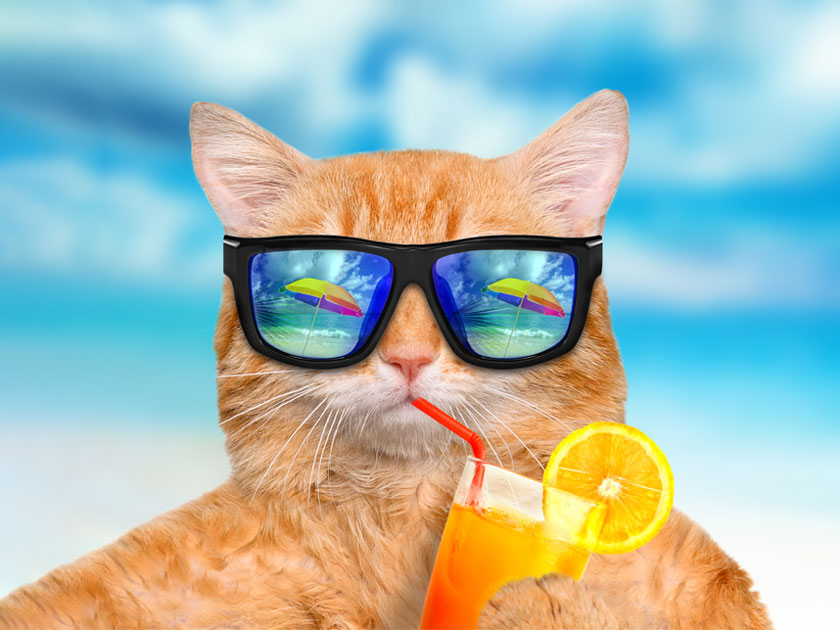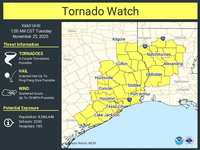- Sections :
- Crime & Public Safety
- Restaurants & Food
- Sports
- More
Categories
Mercury Rising – 5 ways to beat the heat

THE WOODLANDS, TX – We’re officially in summer until September 22, although the temperatures seem to thumb their collective nose at calendars. For weeks now we’ve already been feeling the heat, and chances are it’ll be into October before we feel comfortable running the car and house without AC. Already we're breaking triple digits for our high temps with no real relief in sight.
As trite as it is to complain about the weather, the sad fact is that it can be – and sometimes is – a killer. Bright sun mixed with longer daylight hours and high humidity can make for a calamitous combination quickly. Woodlands Online has five easy tips to keep you safe and (relatively) comfortable during the summer heat.
1. Check your watches and heed your warnings
Local offices of the National Weather Service (NWS) issue certain alerts as conditions warrant:
• Excessive Heat Outlook – Be Aware! The outlooks are issued when the potential exists for an excessive heat event in the next 3-7 days. An Outlook provides information to those who need considerable lead-time to prepare for the event.
• Heat Advisory – Take Action! A Heat Advisory is issued within 12 hours of the onset of extremely dangerous heat conditions. Take precautions to avoid heat illness. If you don't take precautions, you may become seriously ill or even die.
• Excessive Heat Watch – Be Prepared! Heat watches are issued when conditions are favorable for an excessive heat event in the next 24 to 72 hours. A Watch is used when the risk of a heat wave has increased but its occurrence and timing is still uncertain.
• Excessive Heat Warning – Take Action! An Excessive Heat Warning is issued within 12 hours of the onset of extremely dangerous heat conditions. If you don't take precautions immediately when conditions are extreme, you may become seriously ill or even die.
You want to set your phone or Echo to receive weather-related alerts so you’re not caught out in the open or unprepared in a heated situation.
2. Keep an index at your fingers
Our weather is substantially affected by the Gulf stream, making us a much wetter and more humid region than, say, landlocked and dry Wyoming. Knowing the straight temperature is one thing; however, it’s essential for you to factor in the humidity when making outdoor plans.
The Heat Index is a measure of how hot it really feels when relative humidity is factored in with the actual air temperature. For example, if the air temperature is 96°F and the relative humidity is 65%, the heat index is 121°F. Pay attention to forecasts that include the words, “...but it’ll FEEL like…”
3. Know the signs
It may come as a surprise to you to hear that heat exhaustion and heat stroke are two vastly different conditions. Heat exhaustion occurs when the body loses excess amounts of water and salt, typically from sweating. On the other hand, heat stroke is a serious medical emergency that occurs when your body is unable to control its internal temperature. The former is something that you can easily get relief from with a couple of simple steps; but the latter can cause irreversible damage or worse by the time you know you have it.
Symptoms of heat exhaustion include general weakness, increased heavy sweating, a weak but faster pulse or heart rate, nausea or vomiting, possible fainting, lightheadedness, dizziness, and/or pale, cold, clammy skin. Taking a cool shower or using cold compresses, removing layers of clothing, and hydrating with water typically can alleviate these symptoms and move you out of danger. However, signs of heat stroke include elevated body temperature above 104°F, rapid and strong pulse or heart rate, hot, red, dry, or moist skin, and/or loss of consciousness. Under these conditions, it’s essential you immediately get to a cooler and shadier location and call 911.
4. Check your six
According to the National Safety Council (NSC), an average of 38 children under the age of 15 die each year due to being in a hot car, half of those due to the parent or guardian forgetting about their backseat passengers.
Studies have shown that, within one hour, the temperature inside of a car parked in the sun on a day that reached 95°F hit an average of 116°F. On average, dashboards can reach 157°F and the seats can get up to 123°F. Even cars parked in the shade on a hot day can reach 100°F within an hour.
There are apps and technologies that can help you remember to check your back seat whenever you reach a destination; the popular Waze app has an optional alert, and some new models of upscale car seats come with sensors that ding your phone if they get to a certain temperature.
5. H-two-ohhhhh
The Centers for Disease Control and Prevention (CDC) is pretty clear on the importance of keeping hydrated in the heat. Even during a ‘normal’ work day that doesn’t factor in sunlight, heat, exertion, or heavy exercise, it suggests that you stay hydrated even before you start your day, as if you start work dehydrated you might not be able to drink enough to catch up with your body’s need for water.
By the time you feel thirsty, chances are you’re already dehydrated. This can lead to heat hydration before you even realize you’re there. When working in the heat, drink a cup – 8 ounces – of water every 15 to 20 minutes (or about a quart per hour). Use your common sense when taking in water; smaller drinks throughout the day are more effective than gulping down the whole thing at once. Don’t drink more than 48 ounces (six cups) per hour; it can cause a medical emergency because of a diluted salt content in your body. Try to avoid energy drinks due to their higher-than-coffee caffeine content and don’t take salt tablets with your water; as long as you eat normally as you drink, those standard meals will replace your salt in a good balance. Believe it or not, The amount of caffeine in tea, coffee, and soft drinks probably won’t have an effect on overall hydration.
These hot tips can make you a cool cat
As trite as it is to complain about the weather, the sad fact is that it can be – and sometimes is – a killer. Bright sun mixed with longer daylight hours and high humidity can make for a calamitous combination quickly. Woodlands Online has five easy tips to keep you safe and (relatively) comfortable during the summer heat.
1. Check your watches and heed your warnings
Local offices of the National Weather Service (NWS) issue certain alerts as conditions warrant:
• Excessive Heat Outlook – Be Aware! The outlooks are issued when the potential exists for an excessive heat event in the next 3-7 days. An Outlook provides information to those who need considerable lead-time to prepare for the event.
• Heat Advisory – Take Action! A Heat Advisory is issued within 12 hours of the onset of extremely dangerous heat conditions. Take precautions to avoid heat illness. If you don't take precautions, you may become seriously ill or even die.
• Excessive Heat Watch – Be Prepared! Heat watches are issued when conditions are favorable for an excessive heat event in the next 24 to 72 hours. A Watch is used when the risk of a heat wave has increased but its occurrence and timing is still uncertain.
• Excessive Heat Warning – Take Action! An Excessive Heat Warning is issued within 12 hours of the onset of extremely dangerous heat conditions. If you don't take precautions immediately when conditions are extreme, you may become seriously ill or even die.
You want to set your phone or Echo to receive weather-related alerts so you’re not caught out in the open or unprepared in a heated situation.
2. Keep an index at your fingers
Our weather is substantially affected by the Gulf stream, making us a much wetter and more humid region than, say, landlocked and dry Wyoming. Knowing the straight temperature is one thing; however, it’s essential for you to factor in the humidity when making outdoor plans.
The Heat Index is a measure of how hot it really feels when relative humidity is factored in with the actual air temperature. For example, if the air temperature is 96°F and the relative humidity is 65%, the heat index is 121°F. Pay attention to forecasts that include the words, “...but it’ll FEEL like…”
3. Know the signs
It may come as a surprise to you to hear that heat exhaustion and heat stroke are two vastly different conditions. Heat exhaustion occurs when the body loses excess amounts of water and salt, typically from sweating. On the other hand, heat stroke is a serious medical emergency that occurs when your body is unable to control its internal temperature. The former is something that you can easily get relief from with a couple of simple steps; but the latter can cause irreversible damage or worse by the time you know you have it.
Symptoms of heat exhaustion include general weakness, increased heavy sweating, a weak but faster pulse or heart rate, nausea or vomiting, possible fainting, lightheadedness, dizziness, and/or pale, cold, clammy skin. Taking a cool shower or using cold compresses, removing layers of clothing, and hydrating with water typically can alleviate these symptoms and move you out of danger. However, signs of heat stroke include elevated body temperature above 104°F, rapid and strong pulse or heart rate, hot, red, dry, or moist skin, and/or loss of consciousness. Under these conditions, it’s essential you immediately get to a cooler and shadier location and call 911.
4. Check your six
According to the National Safety Council (NSC), an average of 38 children under the age of 15 die each year due to being in a hot car, half of those due to the parent or guardian forgetting about their backseat passengers.
Studies have shown that, within one hour, the temperature inside of a car parked in the sun on a day that reached 95°F hit an average of 116°F. On average, dashboards can reach 157°F and the seats can get up to 123°F. Even cars parked in the shade on a hot day can reach 100°F within an hour.
There are apps and technologies that can help you remember to check your back seat whenever you reach a destination; the popular Waze app has an optional alert, and some new models of upscale car seats come with sensors that ding your phone if they get to a certain temperature.
5. H-two-ohhhhh
The Centers for Disease Control and Prevention (CDC) is pretty clear on the importance of keeping hydrated in the heat. Even during a ‘normal’ work day that doesn’t factor in sunlight, heat, exertion, or heavy exercise, it suggests that you stay hydrated even before you start your day, as if you start work dehydrated you might not be able to drink enough to catch up with your body’s need for water.
By the time you feel thirsty, chances are you’re already dehydrated. This can lead to heat hydration before you even realize you’re there. When working in the heat, drink a cup – 8 ounces – of water every 15 to 20 minutes (or about a quart per hour). Use your common sense when taking in water; smaller drinks throughout the day are more effective than gulping down the whole thing at once. Don’t drink more than 48 ounces (six cups) per hour; it can cause a medical emergency because of a diluted salt content in your body. Try to avoid energy drinks due to their higher-than-coffee caffeine content and don’t take salt tablets with your water; as long as you eat normally as you drink, those standard meals will replace your salt in a good balance. Believe it or not, The amount of caffeine in tea, coffee, and soft drinks probably won’t have an effect on overall hydration.
Comments •




















